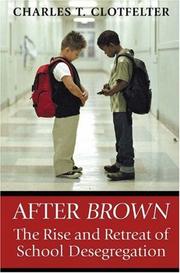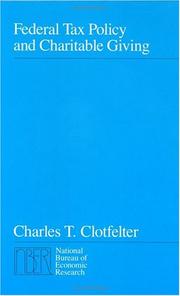| Listing 1 - 10 of 23 | << page >> |
Sort by
|
Book
Year: 1990 Publisher: Cambridge, Mass.
Abstract | Keywords | Export | Availability | Bookmark
 Loading...
Loading...Choose an application
- Reference Manager
- EndNote
- RefWorks (Direct export to RefWorks)
Digital
Year: 1998 Publisher: Cambridge, Mass.
Abstract | Keywords | Export | Availability | Bookmark
 Loading...
Loading...Choose an application
- Reference Manager
- EndNote
- RefWorks (Direct export to RefWorks)
Digital
Year: 1999 Publisher: Cambridge, Mass. National Bureau of Economic Research
Abstract | Keywords | Export | Availability | Bookmark
 Loading...
Loading...Choose an application
- Reference Manager
- EndNote
- RefWorks (Direct export to RefWorks)
Digital
Year: 2000 Publisher: Cambridge, Mass. National Bureau of Economic Research
Abstract | Keywords | Export | Availability | Bookmark
 Loading...
Loading...Choose an application
- Reference Manager
- EndNote
- RefWorks (Direct export to RefWorks)
Multi
ISBN: 9780674982499 Year: 2018 Publisher: Cambridge, Mass. Harvard University Press
Abstract | Keywords | Export | Availability | Bookmark
 Loading...
Loading...Choose an application
- Reference Manager
- EndNote
- RefWorks (Direct export to RefWorks)

ISBN: 9781400841332 9780691126371 Year: 2011 Publisher: Princeton, N.J. Princeton University Press
Abstract | Keywords | Export | Availability | Bookmark
 Loading...
Loading...Choose an application
- Reference Manager
- EndNote
- RefWorks (Direct export to RefWorks)
Book
Year: 1991 Publisher: Cambridge, Mass. National Bureau of Economic Research
Abstract | Keywords | Export | Availability | Bookmark
 Loading...
Loading...Choose an application
- Reference Manager
- EndNote
- RefWorks (Direct export to RefWorks)
Book
Year: 1991 Publisher: Cambridge, Mass. National Bureau of Economic Research
Abstract | Keywords | Export | Availability | Bookmark
 Loading...
Loading...Choose an application
- Reference Manager
- EndNote
- RefWorks (Direct export to RefWorks)

ISBN: 0226110486 9786611223229 1281223220 0226110613 9780226110615 9780226110486 Year: 1985 Publisher: Chicago: University of Chicago press,
Abstract | Keywords | Export | Availability | Bookmark
 Loading...
Loading...Choose an application
- Reference Manager
- EndNote
- RefWorks (Direct export to RefWorks)
The United States is distinctive among Western countries in its reliance on nonprofit institutions to perform major social functions. This reliance is rooted in American history and is fostered by federal tax provisions for charitable giving. In this study, Charles T. Clotfelter demonstrates that changes in tax policy-effected through legislation or inflation-can have a significant impact on the level and composition of giving. Clotfelter focuses on empirical analysis of the effects of tax policy on charitable giving in four major areas: individual contributions, volunteering, corporate giving, and charitable bequests. For each area, discussions of economic theory and relevant tax law precede a review of the data and methodology used in econometric studies of charitable giving. In addition, new econometric analyses are presented, as well as empirical data on the effect of taxes on foundations. While taxes are not the most important determinant of contributions, the results of the analyses presented here suggest that charitable deductions, as well as tax rates and other aspects of the tax system, are significant factors in determining the size and distribution of charitable giving. This work is a model for policy-oriented research efforts, but it also supplies a major (and very timely) addition to the evidence that must inform future proposals for tax reform.
Taxes --- United States --- Income tax deductions for charitable contributions --- Corporations --- Voluntarism --- Charitable bequests --- Mathematical models --- Charitable contributions --- nihil --- Charitable contributions&delete& --- Charities --- Donations --- Taxation --- E-books --- politique fiscale --- Voluntary action --- Volunteer work --- Volunteering --- Volunteerism --- National service --- Associations, institutions, etc. --- Charitable contributions, Income tax deductions for --- Business corporations --- C corporations --- Corporations, Business --- Corporations, Public --- Limited companies --- Publicly held corporations --- Publicly traded corporations --- Public limited companies --- Stock corporations --- Subchapter C corporations --- Business enterprises --- Corporate power --- Disincorporation --- Stocks --- Trusts, Industrial --- Pious bequests --- Pious legacies --- Religious bequests --- Religious legacies --- Charity laws and legislation --- Inheritance and succession --- Legacies --- Charitable uses, trusts, and foundations --- fiscaal beleid --- Mathematical models. --- Income tax deductions for charitable contributions - United States - Mathematical models --- Corporations - Charitable contributions - United States - Mathematical models --- Voluntarism - United States - Mathematical models --- Charitable bequests - United States - Mathematical models --- government, tax, taxation, taxes, finance, financial, economy, economics, charity, gifts, donations, united states, usa, america, american, western, nonprofit, institutions, institutional, social, history, historical, study, academic, scholarly, research, textbook, education, higher ed, college, university, individual, volunteer, corporate, data, methodology, analysis, reform. --- United States of America

ISBN: 0226110508 9786611430818 1281430811 0226110621 9780226110622 Year: 1991 Publisher: Chicago University of Chicago Press
Abstract | Keywords | Export | Availability | Bookmark
 Loading...
Loading...Choose an application
- Reference Manager
- EndNote
- RefWorks (Direct export to RefWorks)
The last two decades have been a turbulent period for American higher education, with profound demographic shifts, gyrating salaries, and marked changes in the economy. While enrollments rose about 50% in that period, sharp increases in tuition and fees at colleges and universities provoke accusations of inefficiency, even outright institutional greed and irresponsibility. As the 1990's progress, surpluses in the academic labor supply may give way to shortages in many fields, but will there be enough new Ph.D.'s to go around? Drawing on the authors' experience as economists and educators, this book offers an accessible analysis of three crucial economic issues: the growth and composition of undergraduate enrollments, the supply of faculty in the academic labor market, and the cost of operating colleges and universities. The study provides valuable insights for administrators and scholars of education.
Public economics --- Higher education --- Service industry --- United States --- College attendance --- College costs --- College teachers --- Education, Higher --- Universités --- Etudes universitaires --- Professeurs (Enseignement supérieur) --- Enseignement supérieur --- Supply and demand --- Economic aspects --- Statistics --- Inscriptions --- Coût --- Offre et demande --- Aspect économique --- Statistique --- Statistics. --- Universités --- Professeurs (Enseignement supérieur) --- Enseignement supérieur --- Coût --- Aspect économique --- Economics --- E-books --- Academicians --- Academics (Persons) --- College instructors --- College lecturers --- College professors --- College science teachers --- Lectors (Higher education) --- Lecturers, College --- Lecturers, University --- Professors --- Universities and colleges --- University academics --- University instructors --- University lecturers --- University professors --- University teachers --- Teachers --- Faculty --- economics, higher education, university, college, public policy studies, industrial, labor relations, american culture, united states of america, usa, demographics, economy, enrollment, students, inefficiency, institutions, educators, undergraduates, faculty, academics, attendance, teachers, professors, costs, productivity. --- United States of America
| Listing 1 - 10 of 23 | << page >> |
Sort by
|

 Search
Search Feedback
Feedback About UniCat
About UniCat  Help
Help News
News